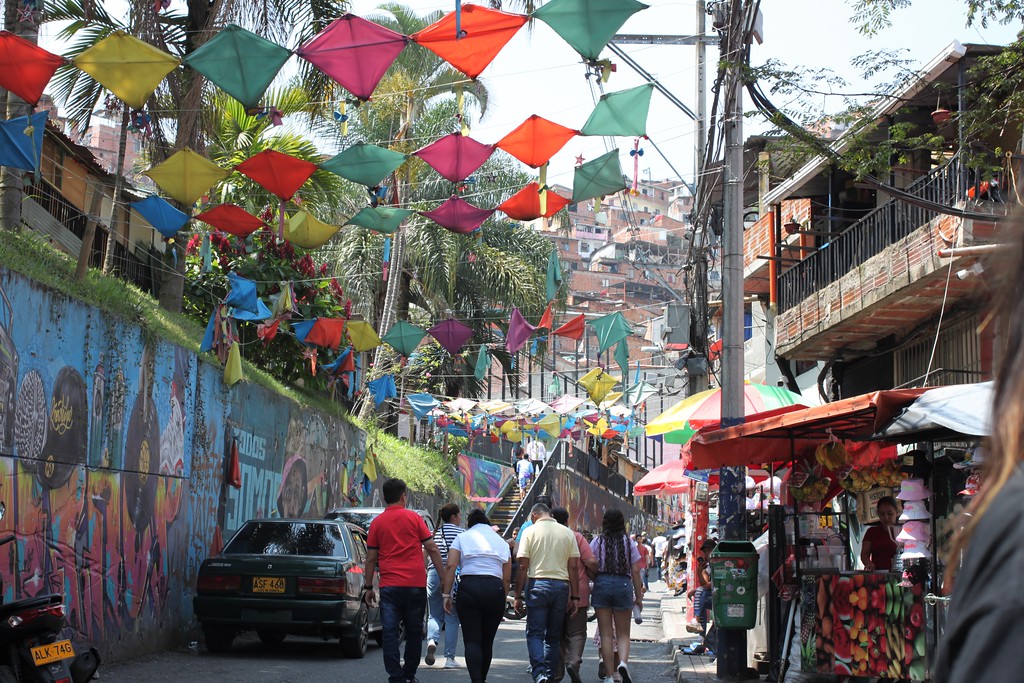Comuna 13, one of 16 administrative areas in Medellín, Colombia, was once considered among the most dangerous areas in the world for its notorious drug trafficking, paramilitary organizations, and gang violence. Today, it attracts 25,000 visitors each week. Travelers come to Comuna 13 to experience its colorful street murals, lively hip-hop culture, and triumphant energy as a neighborhood that has overcome adversity. Government investments in infrastructure, such as the Metrocable and outdoor escalators, aided the shift, improving access to the once-isolated community. But the residents of Comuna 13 have taken part in a different, no less important effort: ensuring that tourism remains a boon to the community and, in the process, providing a vital lesson for other areas facing similar sea changes.
Although there are a few legislative policies addressing the consequences of tourism in Medellín at large, Comuna 13 has formed community agreements to help grapple with the threat of gentrification. In many developing tourist hotspots, investors and outside buyers seize opportunities to purchase properties and rent them to short-term visitors. This can lead to inflated property values, pricing long-time residents out of their homes. Comuna 13 has prevented this by enforcing restrictive policies that hinder tourists from renting properties within the neighborhood. By preventing short-term rentals, the community ensures that housing remains affordable and accessible to its native residents.
While there is no formal legislation banning platforms like Airbnb, the resistance to short-term rentals in Comuna 13 is largely upheld by a strong sense of community. According to local tour guide Stiven Alvarez, “We don’t have any big legal rule that can stop foreign people coming and buying houses and renting them out, but we’re fortunate that people have followed the rules of the neighborhood and have not offered anything to foreign people.” Alvarez emphasized that while the city of Medellín has started regulating Airbnbs in other areas, Comuna 13’s resistance to gentrification relies primarily on the cooperation of all residents rather than government intervention: “Honestly, we don’t have anything legally here. It’s just a big sense of community.” This grassroots approach highlights the strength of the communal bonds that preserve the neighborhood’s character in the face of increasing tourism pressures.
The prohibition against renting properties to visitors dovetails with another informal policy in Comuna 13: restricting tourist activity to the daytime. In many gentrified neighborhoods where visitors can stay for extended periods, local businesses are replaced by those catering specifically to the needs of tourists. In Comuna 13, local leaders and tour operators are responsible for communicating to tourists that overnight stays are discouraged, and other residents comply by not offering such services. Alvarez noted that preventing overnight stays is part of the community’s broader effort to maintain its residential atmosphere: “There are no restaurants after 6:00 p.m., no bars after 7:00 p.m.” By restricting overnight stays and minimizing nightlife, Comuna 13 avoids the pitfalls seen in other gentrified neighborhoods, where tourism overtakes local life and transforms residential areas into hubs for visitors. Comuna 13’s unofficial regulations also prevent the community from assuming a tourist-driven economy dominated by the hospitality industry.
Arguably, Comuna 13’s most crucial strategy for protecting its community involves ensuring that its residents are the primary beneficiaries of the tourism boom. Many of the vendors, tour guides, and street artists who entertain visitors are also long-time residents of the community. The economic benefits of tourism are not siphoned off by outside businesses seeking to capitalize on the neighborhood’s popularity—instead, tourism directly supports the people who have lived in and contributed to the fabric of Comuna 13. This not only promotes the financial stability of residents but also uplifts the cultural and social identity of the neighborhood: Visitors to Comuna 13 engage directly with the people whose lives and histories have shaped the neighborhood.
These three agreements—restricting property rentals, preventing nighttime tourism, and ensuring local ownership—are what set Comuna 13 apart from other communities struggling with gentrification. Although these policies are legislatively informal, they are upheld by community buy-in. While tourism continues to reshape the neighborhood, these measures have helped the neighborhood retain its cultural authenticity, allowing residents to continue living normally—albeit with many more visitors. This neighborhood offers an important lesson to other communities that face the risk of being consumed by tourism: By enforcing thoughtful policies that prioritize residents over short-term gains, neighborhoods can balance tourism and cultural preservation, creating a sustainable future for their people.
